The Story Of OnLive
The video game industry is constantly throwing new platforms at us, and that’s a good thing. Atari once ruled; now it’s out of the console business. People once feared a Nintendo monopoly; now it’s one of three major competitors. SEGA was once Nintendo’s chief rival, but it, too, dropped out of contention. Browsers and iOS are making inroads against hardware in general. This constant jockeying for position means that game companies stay on their toes and deliver the best products possible.
Lately we’ve been hearing that new business models are going to shake things up even more. But last week there was a major setback to that prediction: OnLive, which was supposed to be the David to the industry’s Goliath, sold out to a venture capitalist and laid off more than half its staff.

OnLive was announced as a scrappy startup in 2009, and it’s based on a great idea. Basically, OnLive offers consumers the ability to play games remotely; all of the heavy-duty processing is done on OnLive’s computers, which communicate with the player’s device via the Internet. This allows people to play games that their own computers aren’t powerful enough to handle. It also frees up hard drive space, because huge game files don’t have to be saved locally.
In a world where the biggest game companies are sticking to disk and hard-drive storage—and releasing expensive consoles and PCs with powerful processors—OnLive looked like a dream come true. But the company simply did not make the inroads it thought it would.
From the beginning, OnLive has had its critics—those who claimed the Internet could not transmit data quickly and reliably enough to make this type of service possible, at least not without serious compromises. The process needs to be instantaneous—your control inputs need to register on the screen right away—and the games need to compete graphically with their non-streamed versions. Some thought OnLive would never see an official release.
OnLive defied the odds, but early reviews varied. The service was functional, but it couldn’t quite compete with the experience of actually owning a game and playing it on your own machine. There was just a little too much lag and just a little too much graphical compression, and the system requirements were just a little too high.

OnLive continued to improve and expand, but nonetheless the hammer fell. Though 2 million people signed up for OnLive, very few of them became regular users—reportedly, at any given time, only about 1,600 people were logged on. The dropoff showed that OnLive was failing to impress the people who tried it, and this level of traffic simply could not sustain the number of employees and servers the company had acquired.
So, last week, OnLive changed hands and shed a lot of employees. This is, of course, a great loss to all of those who are personally involved. But it also means something for gaming.
- Page 1
- Page 2
